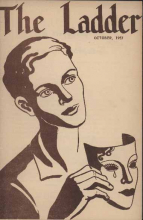Historical figures from ancient Greece and Rome have played a vital part in the construction of modern queer identities, via both identification and difference. The politics of sexuality has, in turn, influenced both the study of such figures and their representation in creative and scholarly works. These papers explore, collectively, the capacity for ancient historical figures to serve not only as icons for the self-definition of queer "tribes", but as ambassadors negotiating the terms in which such tribes are represented--by themselves and others--to larger communities in which they are embedded.
CONTENTS
Introduction (Ruby Blondell)
Sculpting Antinous (Bryan Burns)
Lesbians are from Lesbos: Sappho and Identity Construction in The Ladder (Jody Valentine)
From “Filthy Catamite” to “Queer Icon”: Elagabalus and the Politics of Sexuality (1960-1975) (Mark Nugent)
The Trouble With Icons: Recent Ideological Appropriations of Plato's Symposium (H. Christian Blood)
The Alexander Bromance: Male Desire and Gender Fluidity in Oliver Stone’s Historical Epic (Konstantinos P. Nikoloutsos)
